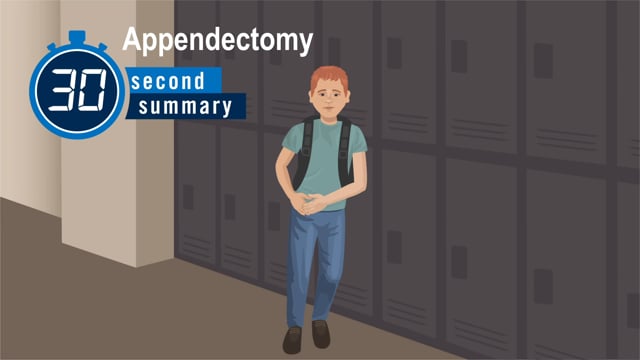Appendectomy
What Is an Appendectomy?
An appendectomy is surgery to remove the appendix. Surgeons remove the appendix when it gets blocked and becomes infected. This is called appendicitis.
Appendicitis needs urgent treatment. Usually, the appendix must be removed. Appendectomy is a common procedure, and most kids recover quickly and with few problems.
-

30-Second Summary: Appendectomy
Learn the basics in 30 seconds.
Why Is an Appendectomy Done?
The appendix is a small organ in the lower right side of the belly. It is attached to the large intestine. Sometimes the appendix can get blocked with hard poop, swollen lymph nodes, or parasites.
Appendicitis develops when bacteria (germs) grow and the appendix becomes inflamed and swollen.
What Happens Before an Appendectomy?
Most appendectomies are unplanned. So parents don't need to do much to get ready.
You and your child will meet with the care team, review your child's medical history , and hear about what to expect. The anesthesiology team will also ask about your child's medical history and when your child last ate and drank.
Before the surgery begins, the care team will set up monitors to keep track of your child's vital signs (like blood pressure and oxygen level) and put in an intravenous line (IV) to give medicines and anesthesia.
What Happens During an Appendectomy?
Kids and teens having an appendectomy will get general anesthesia. This lets them sleep through surgery.
Your child's surgeon will choose the surgery method that's best for your child. There are two types of appendectomy:
Laparoscopic appendectomy: Most of the time, surgeons remove the appendix with the help of a tiny video camera called a laparoscope. It lets them see inside the body while looking at a special TV monitor. The surgeon makes a small incision (cut) in the belly button and inserts the thin tube of the laparoscope. The laparoscope acts as the surgeon's "eyes" as it is guided to the appendix. The surgeon may make two more small incisions for the medical instruments. Using the instruments, the surgeon carefully cuts the appendix away from the large intestine and removes it. The incisions are closed with dissolvable stitches and covered with small bandages.
Open appendectomy: This is the "traditional" way of removing the appendix. The surgeon makes an incision (cut) in the belly, then carefully cuts the infected appendix away from the large intestine and removes it. The surgeon closes the incision with stitches.
What Happens After an Appendectomy?
After an appendectomy, most kids stay in the hospital for less than a day. Kids at higher risk for infection may need to stay longer to get IV antibiotics. This is typical for kids whose appendix ruptures (bursts) before the appendectomy.
Before going home, you'll get instructions on how to care for your child at home and when to come back for a follow-up visit. You'll learn how to take care of the incision(s), manage any pain, and find out if there are any restrictions on physical activity or returning to school.
With a little rest and care, most kids recover from an appendectomy with little difficulty.
Are There Any Risks From an Appendectomy?
All surgeries come with some risks. The surgical team will discuss them with you before the surgery and do everything possible to minimize them. If you have any concerns, be sure to bring them up before the surgery.
Complications of appendectomy can include:
- infection
- problems from anesthesia
- bleeding
- an allergic reaction
How Can Parents Help?
At home, your child will need to rest and recover. During that time:
- Follow the care instructions the surgical team gave you.
- Call the doctor's office if you have any questions.
- Tell the staff at your child's school about the surgery and any restrictions your child has.


